Last Updated on December 21, 2024 by Kittredge Cherry
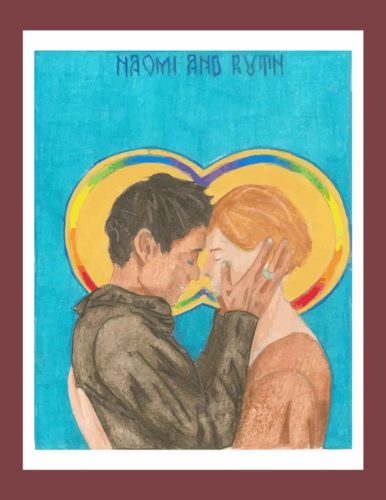
Love between women is honored in the lives of Biblical figures Ruth and Naomi. The two women are an inspiration for lesbians and the whole LGBTQ community.
Ruth’s famous vows to Naomi are often used in weddings — heterosexual as well as same-sex marriages. Few people realize that these beautiful promises were originally spoken by one woman to another:
“Where you go I will go, and where you stay I will stay. Your people will be my people and your God my God.”
(Ruth 1:16-17)
Ruth and Naomi have joined halos in portraits by Katy (Keats) Miles-Wallace (at the top of this post) and Kelly Latimore.
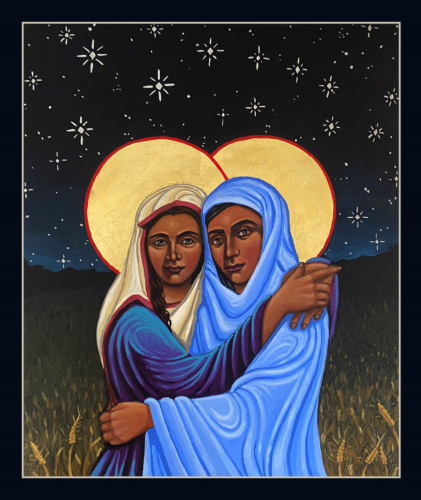
“Ruth and Naomi” by Kelly Latimore, 2022
The old-fashioned King James translation, still beloved by many, begins, “Whither thou goest, I will go…” The story is written in Hebrew in the Hebrew scriptures, also known as the Old Testament.
There are no wedding ceremonies in the Bible, so the same-sex vows between Ruth and Naomi and David and Jonathan provide the best Biblical models for wedding vows.
Churches honor her as Righteous Ruth, Ruth the Matriarch, Ruth of Moab or Ruth or the Holy Foremother. Orthodox churches commemorate Ruth along with others on the Sunday of the Holy Genealogy (or Sunday of the Holy Forefathers), which falls on the Sunday between Dec. 11-17. Her feast date is July 16 in the Lutheran church and Nov. 1 in the Catholic tradition.
Were Ruth and Naomi lesbians? It is impossible to know the reality of their relationship. The same Hebrew word (dabaq) is used to describe Adam’s feelings for Eve and Ruth’s feelings for Naomi. In Genesis 2:24 it says, “Therefore shall a man leave his father and his mother, and shall cleave unto his wife: and they shall be one flesh.” The way that Adam “cleaved” to Eve is the way that Ruth “clung” to Naomi. Countless couples have validated this interpretation by using their vows as a model for how spouses should love each other. Because of her heterosexual marriages, Ruth may also be considered bisexual.
A billboard featuring Ruth and Naomi is part of the Would Jesus Discriminate project sponsored by Metropolitan Community Churches. It states boldly, “Ruth loved Naomi as Adam loved Eve. Genesis 2:24. Ruth 1:14.” The website WouldJesusDiscriminate.org gave a detailed explanation. For more info on the billboards, see the previous post, “Billboards show gay-friendly Jesus.”
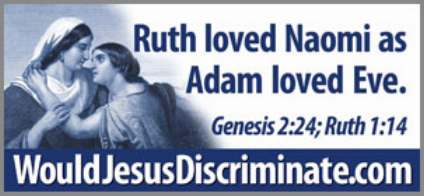
Ruth and Naomi billboard from from WouldJesusDiscriminate.org
Ruth and Naomi in the Bible
Ruth was part of a Moabite pagan family before she married the son of a Judean couple living in Moab. In Judaism she is honored as a convert. Naomi was the mother-in-law of both Ruth and Orpah. After their husbands died, Naomi urged both of them to return to their families and remarry. But Ruth refused, declaring her love in words that have extra meaning for LGBTQ people because they were spoken between women.
Ruth stuck with Naomi, and they moved to Bethlehem, where Ruth married the Jewish man Boaz. Their son, Obed, became the grandfather of King David, whose same-sex love relationship with Jonathan is seen as a role model among LGBTQ people of faith.
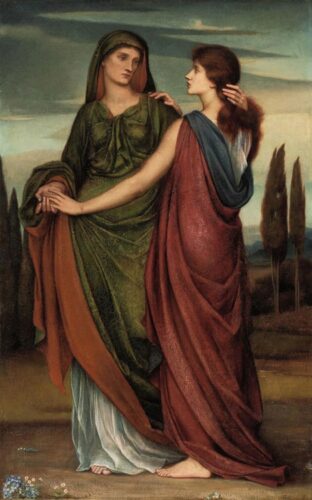
“Naomi and Ruth by Evelyn de Morgan, 1887 (Wikipedia)
The Bible story ends there, so there is no record of their relationship as they aged or whether Ruth fulfilled the second part of her vow to Naomi: “Where you die I will die, and there I will be buried.” An ancient building identified as the tomb of Ruth and Boaz is located in Hebron, a Palestinian city in the southern West Bank, south of Jerusalem.
Ruth is an ancestor of Jesus Christ, listed in his genealogy in the gospel of Matthew. It reports mostly a male lineage, and Ruth is one of only five women who are included. (The others are Tamar, Rahab, the “wife of Uriah” (Bathsheba) and Mary.)
Lesbian interpretations of Ruth and Naomi
The openly lesbian interpretation dates back at least to 1937, when the novel “Pity for Women” by Helen Anderson was published. The two main characters, Ann and Judith, recite Ruth’s famous vow to show their commitment as a lesbian couple.
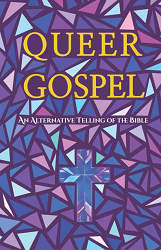 “Queer Gospel: An Alternative Telling Of The Bible” by Riley Alerton reimagines the Bible with “the good queens Ruth and Naomi of Lesbos” helping exiled heteros. The novel is on Q Spirit’s list of the top LGBTQ Christian books of 2022.
“Queer Gospel: An Alternative Telling Of The Bible” by Riley Alerton reimagines the Bible with “the good queens Ruth and Naomi of Lesbos” helping exiled heteros. The novel is on Q Spirit’s list of the top LGBTQ Christian books of 2022.
Ruth and Naomi also play a role in the award-winning 1971 lesbian historical novel “Patience and Sarah” by Isabel Miller. In 19th-century New England, love blossoms between Patience, an educated painter of Bible scenes, and cross-dressing farmer Sarah. The first picture that Patience paints when they move in together is the embrace of Biblical women Ruth and Naomi.
Contemporary Christian singer-songwriter Marsha Stevens used their vow as the basis for the song she wrote for her legal wedding to Cindy Pino: “Wherever You Go.” She sings about how Cindy grew up feeling alone as “a guest at every wedding, an extra place at meals,” with nobody recognizing her lesbian relationships as family. But the mood shifts after a chorus with Ruth’s vow to Naomi :
Now we stand on sacred ground, our families near,
Law allows these holy vows, your home is here.
“Wherever You Go” is available for listening and download at BALM (Born Again Lesbian Music) Ministries: http://balmministries.net/track/323379/wherever-you-go
Ruth and Naomi in art
Ruth and Naomi share a rainbow halo in an icon created in 2017 by queer Lutheran artist and seminarian Katy (Keats) Miles-Wallace as part of her “Queer Saints” series. It appears at the top of this post. The series presents traditional saints with queer qualities and heroes of the LGBTQ community.
The icons are rooted in queer theology and in Miles-Wallace’s eclectic faith journey that began at a Baptist church in Texas and led to study at Pacific Lutheran Theological Seminary in Berkeley, California. She drew many of them on the altar of a seminary chapel. For more info, see the Q Spirit article “New icons of Queer Saints created by artist Katy Miles-Wallace.” The icons may be available as prints, jewelry and more at the Queerly Christian Zazzle shop.
Ruth and Naomi share golden halos in a 2022 icon by Kelly Latimore. He is known for painting innovative icons of unlikely contemporary saints such as Stonewall saint and trans activist Marsha P. Johnson and the migrant family in his best-known work “Refugees: La Sagrada Familia.” He began painting icons in 2011 while he was a member of the Common Friars, an Episcopal monastic community in Athens, Ohio.
Enjoy a selection of Bible illustrations that celebrate the love between these two women of spirit. If you look closely, it sometimes seems that they are about to kiss.

The previous two images are details from larger scenes that show Orpah leaving while Ruth stays with Naomi.
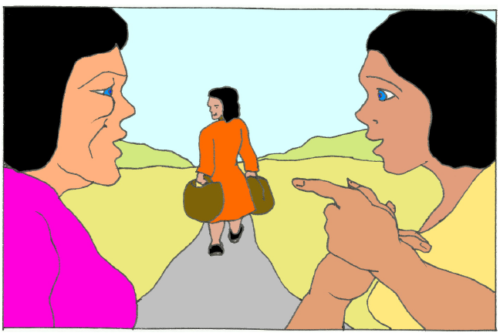
As Orpah leaves, Ruth tells Naomi, “Do not press me to leave you” in an illustration from the book “Heavenly Homos, Etc.: Queer Icons from LGBTQ Life, Religion, and History” by Jan Haen.
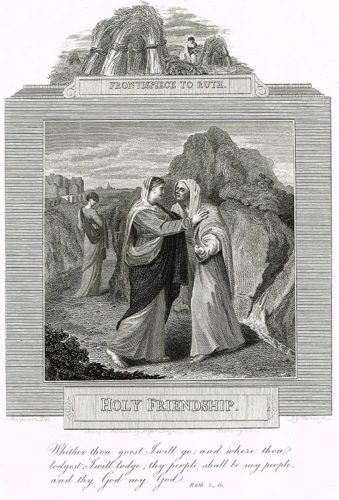
Ruth makes a vow to Naomi in an engraving from the 1815 book “Impartial Expositor and Family Bible” by Ezekiel Blomfield, published by Brightly and Childs. An original was available from Sandtique Rare Prints.
Artist Brandon Buehring included Ruth and Naomi in his “Legendary Love: A Queer History Project.” He uses pencil sketches and essays “to remind queer people and our allies of our sacred birthright as healers, educators, truth-tellers, spiritual leaders, warriors and artists.” The project features 20 sketches of queer historical and mythological figures from many cultures around the world. He has a M.Ed. degree in counseling with an LGBT emphasis from North Carolina State University in Raleigh. He works in higher education administration as well as being a freelance illustrator based in Northampton, Massachusetts.
An icon of Ruth and Naomi appears on prayer cards expressing non-traditional family commitment and love. Used to be available from the Silver Crow shop on Etsy.
Ruth and Naomi’s love has been illustrated by many artists, including the great English Romantic painter William Blake.

Ruth and Naomi share a loving moment with each other and Naomi’s baby son Obed in an 1860 drawing by Simeon Solomon, 1860. (Wikimedia Commons)
The hardships experienced by Ruth and Naomi are often overshadowed by their famous vow of love and their association with the giving of the Torah to the Jewish people. Ruth is revered as a Jewish convert and an ancestor of Jesus. But Ruth and her Israelite mother-in-law were so poor that Ruth had to survive by picking up leftover grains of barley in the fields after harvest. Gay Israeli artist Adi Nes brings home the reality of their poverty by showing the pair scavenging onions from a contemporary street littered with trash after an open-air market. They are posed like the peasants in Millet’s “The Gleaners,” a painting well known for showing the dignity of society’s poorest members.
The careworn faces of Ruth and her beloved Naomi become visible in a second portrait by Nes. He shows that their love for each other is all they have as they sit together among discarded crates. For more about Adi Nes, see my previous post “Adi Nes: Gay Israeli artist humanizes Bible stories.”
The painting below, “Whither Thou Goest” by Trudie Barreras, was commissioned in 2004 by Rev. Paul Graetz, pastor of City of Light / First Metropolitan Community Church of Atlanta, for a sermon series that he was doing on the Book of Ruth.
 “Whither Thou Goest” by Trudie Barreras, 2004
“Whither Thou Goest” by Trudie Barreras, 2004Acrylic, 18” x 14.” Collection of City of Light / First Metropolitan Community Church of Atlanta, GA.
Ruth and Naomi in music
Ruth’s vow to Naomi is set to sacred choral music in “Entreat Me Not To Leave You” by American composer Dan Forrest, from the album “Music of the Living.” The song conveys the intense love between Ruth and Naomi by beginning quietly, building to a climax with the words “where you die, I will die,” and returning to a more meditative mood at the end.
The vow between Ruth and Naomi is expanded to extend love to whole communities, such as immigrants and Muslims, in “Where You Go” by Shoshana Jedwab, singer/songwriter, Jewish educator and ritual leader.
Ruth and Naomi in prayer
Here is my queer prayer inspired by Ruth and Naomi:
O God, inspire us to love one another
as Ruth and Naomi loved each other.
They gave us a powerful example
of love between women.
May their love guide same-sex couples
and all couples into a deeper connection
with each other and
with the Spirit who created us to love. Amen.
Ruth and Naomi links
Queering the Church: Ruth and Naomi
Stroppy Rabbit Blog: Naomi and Ruth in art
Conjubilant with Song Blog: “Song of Ruth” hymn by Fanny Crosby, 1875
Before Stonewall, Episode 4: The Story of Ruth and Naomi (video by Chad Denton)
___
To read this article in Spanish, go to:
Rut y Noemí: El amor entre mujeres en la Biblia (Santos Queer)
___
תפילת משיח קשת בענן (Rainbow Christ Prayer in Hebrew from Q Spirit)
___
Top image credit:
“Naomi and Ruth” by Katy (Keats) Miles-Wallace. The icons may be available as prints, jewelry and more at the Queerly Christian Zazzle shop.
___
This post is part of the LGBTQ Saints series by Kittredge Cherry. Traditional and alternative saints, people in the Bible, LGBTQ martyrs, authors, theologians, religious leaders, artists, deities and other figures of special interest to lesbian, gay, bisexual and transgender and queer (LGBTQ) people and our allies are covered.
This article has evolved and expanded greatly since the first version was posted in December 2009. It was published on Q Spirit in December 2016, was enhanced with new material over time, and was most recently updated on Dec. 21, 2024.
Copyright © Kittredge Cherry. All rights reserved.
Qspirit.net presents the Jesus in Love Blog on LGBTQ spirituality.




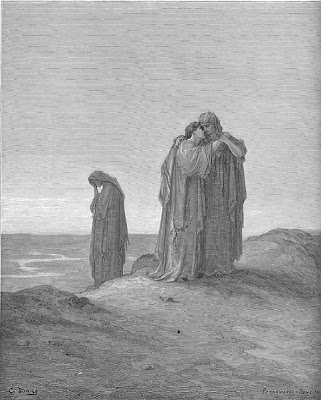




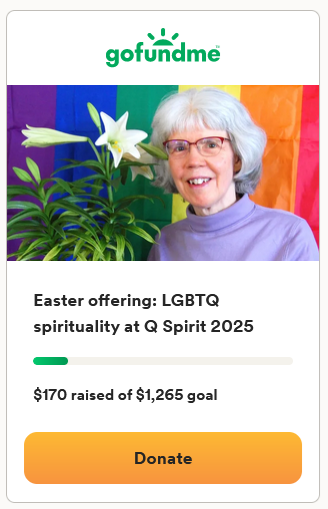



















Thank you so much for writing this article. I never knew the Bible contained a beautiful story of queer love.
I suppose you didn’t even notice that right after the sentence describing Ruth “clinging” to Naomi (which you think indicates a “marriage”), the very next sentence says Naomi told Ruth to leave with Orpah rather than staying with her – in which case we’re supposed to believe Ruth and Naomi got married in that instant and then Naomi immediately told her to leave? Here’s the full section, verbatim (Ruth 1: 14-15): “At this they wept aloud again. Then Orpah kissed her mother-in-law goodbye, but Ruth clung to her. “Look,” said Naomi, “your sister-in-law is going back to her people and her gods. Go back with her.” And a bit farther down (Ruth 2:2), Naomi calls Ruth her “daughter” (not “lover” or “wife”), and in Ruth 3, Naomi tells Ruth to attract a man named Boaz by putting on perfume and lying down at Boaz’s feet, then in Ruth 4, Naomi arranges for Ruth and Boaz to get married. But you want us to believe that Ruth and Naomi were also married at the same time?
As for the Hebrew word “dabaq” which you think indicates a marriage: as someone else pointed out in another comment, “dabaq” doesn’t mean “to marry” or anything similar: it means to remain in a given condition/location or physically cling to something, and is used in many Biblical passages that way. You cherry-picked a single passage from Genesis about Adam and Eve and took it out of context : the word “dabaq” in that passage isn’t the part that establishes that they married each other but rather other phrases such as the phrase describing how they became “one flesh”. Ruth and Naomi were never described in any similar fashion, in fact Naomi arranged for Ruth to marry a man.
You claimed that Ruth’s pledge to Naomi – “Where you go I will go, and where you stay I will stay. Your people will be my people and your God my God” – is a wedding vow because a somewhat similar phrase has now been adopted in modern times by some churches; but Ruth’s statement explicitly mentions adopting Naomi’s God rather than going back with Orpah to their own people and pagan gods, hence it’s about adopting a new religion and culture, not a marriage. The modern vows you’re mentioning have only adopted something vaguely similar to this statement and this modern practice does not mean that people thousands of years ago were using this variation of the phrase as a wedding vow (unless you think time travel was involved?) All of this is just incredibly bad logic.
You also claimed that “There are no wedding ceremonies in the Bible, so the same-sex vows between Ruth and Naomi and David and Jonathan provide the best Biblical models for wedding vows.” which is also terrible logic since it’s basically circular reasoning (i.e. the assumption that these were same-sex marriages is being used to prove itself by just assuming these statements were wedding vows, therefore the original assumption that these were same-sex marriages must be true).
I perceive this as brotherly / sisterly love & Philo’s / Theo’s & agape being more adequate. We are to hug / embrace & kiss as Christians Amen / Awomen & to Praise God*
I completely support same-sex marriage, but treating every example of “love” as “romantic love” does the LGBTQ community no favors, and minimizes the very richness of Love – which takes on many forms of which romantic love is only one. Two women can love each other and not be lesbians. Two men can love each other and not be gay. This is a mother-in-law and daughter-in-law who effectively become mother and daughter. Why are you pretending it’s a same-sex marriage when it obviously isn’t?
Why is your interpretation the only one that matters?
I’m flabbergasted by your understanding of Naomi and Ruth’s relationship. Yes, Naomi did in fact love Ruth and vice versa. You seem to be refusing to know where that love stemmed from. Or you do, but choosing to upload false information to the public to make a lifestyle of homosexuality seem ok in GOD’s eyes…it is not! Ruth was married to Naomi’s son before he died. Naomi was a mother figure to Ruth. Naomi helped her daughter-in-law Ruth gain the attention of Boaz, whom she later married. Truth is always better. Why flip the Bible to benefit a lifestyle. The Bible is,… what it is. What you posted is actually worse than the people who don’t know and taking what you posted as truth. Proverbs 6:16-19 and Proverbs 12:22, states that lying is an abomination and further down in Proverbs 21:6, tells about the Wrath of GOD for a lying tongue.
What lies? Everything you just mentioned was in the post. So?
How can anyone take the relationship Ruth had with her mother in law out of content to benefit their beliefs. I just can’t comprehend that anyone would take a daughter in laws love for her mother in law as being a lesbian actions. Ruth was loyal to Ruth and Ruth believed in the same God as Naomi does so she went back to Naomi’s promise land to be closer to God even though she was a Moabite. Ruth loved Naomi like a child loves there mother. I wish people would not twist innocent kind caring words to benefit them God made man for woman that’s how it’s always been. I’m a Christian and I’m not mocking how anyone feels about other people but don’t twist the love Ruth has for Naomi to be made out as lesbians that’s just not how God intended those words to be taken to a whole new level
Why would that be “twisting”?
THEY ARENT GAY! Ruth looked up to her mother in law as a mother!!! She was a Godly woman and wasn’t homosexual. Plus if she did believe in the same God she would also respect the same law that God made, where he said male or female lying in bed with each other is a large sin! God shows many sins He abhors, and if I get the argument of the meaning of the word search the Torah and the Greek translations. It’s a sin in many languages.
Actually Bob, God states in the Bible that no one sin is greater than another so you saying that being homosexual is a large sin shows your own ignorance and inability to see any perception but your own. Second God mentions lying thousands of times but only mentions homosexuals once… and the actual translation of the ‘ a man shall not lay with another man, it’s an abomination’ actually is more accurately translated to ‘a man shall not lay with another man in the bed of his wife’! Very different! Thirdly the verses where you see the word homosexual were translated from the word sodomite which when describes in the Bible never included homosexuals so they added that in later translations! Lastly, The vow that Ruth made to Naomi was not and is not something you would normally say to your mother in law, or anyone except a spouse.
Nothing gay or lesbian between Naomi or Ruth. I love Naomi & don’t think she is given enough credit for the powerful loving example she demonstrated. Naomi, Ruth & Oprah had all lost significant men in their lives, does not mean they clung to each other in a sexual way.
The entirety of this supposition is based on the use of the Hebrew word dabaq pronounced daw-bak’. Because you reference this word only in Genesis and only in Ruth, you predispose the reader to give it more significance than it likely holds. You imply meaning by only crediting these two instances; however, there are many other examples of the use of the word dabaq in the Bible most of which have no implications of spousal love. Here is a list of other uses:
Deut. 28:21 “The LORD will make the pestilence cling (dabaq) to you until He has consumed you from the land where you are entering to possess it.
Joshua 23:12 “For if you ever go back and cling (dabaq) to the rest of these nations, these which remain among you, and intermarry with them, so that you associate with them and they with you,
1 Samuel 14:22 When all the men of Israel who had hidden themselves in the hill country of Ephraim heard that the Philistines had fled, even they also pursued them closely (dabaq) in the battle.
2 Samuel 23:10 He arose and struck the Philistines until his hand was weary and clung (dabaq) to the sword, and the LORD brought about a great victory that day; and the people returned after him only to strip the slain.
1 Kings 3:3 Nevertheless, he clung (dabaq) to the sins of Jeroboam the son of Nebat, which he made Israel sin; he did not depart from them.
2 Kings 5:27 “Therefore, the leprosy of Naaman shall cling (dabaq) to you and to your descendants forever.” So he went out from his presence a leper as white as snow.
Psalm 22:15 My strength is dried up like a potsherd, And my tongue cleaves (dabaq) to my jaws; And You lay me in the dust of death.
I listen to my heart as I believe the holy spirit writing on our heart is the only unalterable word of God, and everything I hear is that Love should never be condemned. God is love. The amount of evil words and ridicule that people direct towards the lbgt community is a direct sign of who those people are, not who they condemn. It still astonishes me that those who claim to be Christian can have so little grasp of God’s Word. The first 2 commandments say it all. Love Him, and love one another, and that comes before any other commandment. The Bible is paper and print, it is not magically protected by a force field and God does not live in it or it would be part of the trinity. It has already been proven alterable, and people ignore that. The agenda of any number of religious men could have made its way onto the pages of thd bibke before anyone was aware and the way to make sure people believed it would be to add something about how it won’t ever change. God is love. Love covers a multitude of sins. I am not a lesbian, but believe me, men have broken my spirit so badly that I truly wish I were. Your love for God shines through in your writing. That is beautiful and the good influence that the younger lbgt generation needs. You are a light. I wish more Christians could listen to their hearts and know that. I was reading about Naomi because that is my youngest daughter’s name, and your writing made me that much more pleased as she has more love in her young sole than any human I have ever known, and it sounds like you do too. I read this and felt love. How anyone could shame that, is shameful in itself. God bless you and your loved ones.
You have taken a beautiful Bible passage out of context to promote your belief system. If you look at the verses within context, Yes, we see that it is indeed being said between a daughter in law to her mother in law. There is of course genuine love and loyalty within such family bonds. This is to be easily understood and the stretch of a lesbian lover situation is a far stretch to this act of devotion. Please notice that Ruth also adds, “Your God will be my God.” that line is of utmost importance here in understanding the story and it’s meaning. Ruth had come to worship and love God and did not intend to return to the pagan “gods” of Egypt. The God of the Bible that she is speaking of, the God of Abraham, Isaac and Jacob called same sex sexual unions as an abomination. It’s the highest form of rebellion by saying, you are not even who God created you to be. Please, I urge you to stop twisting the scriptures to suit your worldview or personal agenda. That is what Satan did in the Garden of Eden, very cleverly twisted God’s holy words in order to deceive……women for his personal gain. Consider that he may be deceiving you in the same manner in this day. We know that in the last days, a great falling away will happen and a great delusion will be aimed at believers.
This is disturbing and so blasphemous. How dare you “Interpret“ something so ignorant and clearly evil! She held onto her mother-in-law because she loved her first husband so much and they went through something very traumatic. The LGBT community doesn’t receive hate! We want y’all to change for the better. Because gay comes from abuse or one mistake one Shameful night! But there is forgiveness , the reason it’s called “Pride” is because it’s a mockery from satan of what Gayness really is & that’s SHAME. It’s shameful to be Gay, there’s nothing but sadness, confusion and child abuse behind Gayness. How dare you and THE LGBT community take something so sacred out of context. How sad. Please repent. God heals all conditions, even gayness.
Let us not forget that Ruth married again, to a man, Boaz, and had a child with him, Obed.
Ruth, Naomi, and Orpah all lost their husbands. They were devastated. Imagine all women of a family losing their husbands. Of course it is not odd to think they would cling to one another for support during tragedy. People will cling to one another for emotional support and even financial support. They became destitute. They wanted to work together to rebuild their lives.
Ruth was more inclined to stick with the woman who she’d grown close to, and felt a bond enough to follow the ways of Naomi, a woman who had a strong bond with one god and the traditions of her people, not of the pagan gods. She was willing to leave her traditions for that of another.
This is why the Bible instructs us to be people that reflect the goodness of God, so that when others come to know you, they’ll want to know why– it’s because of God’s love.
Also, people who no longer wanting to keep reliving the sad memories of their past will sometimes move to another city or even a new country to restart their lives. Moving with her mother-in-law does not mean she loved her as a bisexual. Orpah, tried for a short while to send Naomi back, but she couldn’t stay, she wasn’t willing to go that far, and went back. But Ruth, she was driven to begin a new life.
No where does the Bible says it was a “lesbian” relationship. Now, you can believe what you want, but misleading people by teaching this as the likely case, is unfounded. Not all forms of love are sexualized love.
I have an incredible loving bond with my daughter with absolutely zero of the love being sexualized.
Naomi’s love to Ruth was like that of a mother and her daughter. As the person above mentioned, “dabaq” is used other times in the Bible, with no reference to it meaning sexual attraction or bond.
Are you actually dumb? LGBT community is not supported by the Bible. Please do tell me what verse says that gay relations is ok! Leviticus 18:22 says “If a man lies with a male as with a woman, both of them have committed an abomination; they shall surely be put to death; their blood is upon them.” The same goes to a woman loving a woman in a sexual way. It is an abomination. Marraige and sexual feelings are to only be between a man and a woman.
Scripture does not condemn loving, responsible homosexual relationships. There are many resources that fully explain the Bible and homosexuality. Here are a few that I recommend:
The Bible and Gays: Is it a sin to be gay? Did Jesus condemn homosexuality?
http://mccchurch.org/resources/mcc-theologies/
http://www.gaychurch.org/
“What the Bible Really Says about Homosexuality” by Daniel Helminiak
Hi Lace
There is no verse in the Bible condemning same sex relations and activities between two women. The oft-quoted clobber verse Romans 1:26-27 is misinterpreted to mean sexual relations between two women is sin when actually, if you read it, it is referring solely to sexual activity between two men.
Please add me to your mailing list.
Thanks, Cindy! You are added to the email list. You will receive the monthly Jesus in Love Newsletter on LGBTQ spiritulaity.
Here is a link where others can get more info and sign up:
http://conta.cc/1jxGOIv
umm, Ruth was her daughter in law. It is entirely possible to love someone, even love them very much, and not have any sexual attraction to them. Pulling stuff out of context so you can make the Bible pro-gay doesn’t make it so.
Thank you.
Is there no area of the LGBTQ community that is left unexamined by genius of Kittredge Cherry? Her insight, care, and deep concern brings forth, for our own understanding, growth,
and delight, both the worlds of the deep interior dimension of spirit and past and present cultural and artistic expressions within and outside of society’s institutions. For a jolt of inspiration and for the joy of being gay I often turn to Kittredge for hydration. For her, artist, musician, author and poet we raise our voice saying, gratias agamus Domino Deo nostro.
I love how to put that! Your words of appreciation mean a lot to me, especially this week when I’m getting some nasty hate mail over my queer Nativity scenes.
I had to look up your Latin phrase, although I often said it in English while celebrating communion. Dominus vobiscum!